Cham Cham, also spelled as Chum Chum is one of the most classic sweets from Bengal. So, there, it can also be pronounced as Chom Chom. The word ‘chum’ also means a close friend. And that’s what this Cham Cham Sweet will be. Once you get to try it, you would definitely form a friendly bond with it! This sweet is easy to prepare, but does take some time and the procedure resembles that of making a Rasgulla. This recipe demonstrates a stuffed variation. But you can relish it otherwise too.
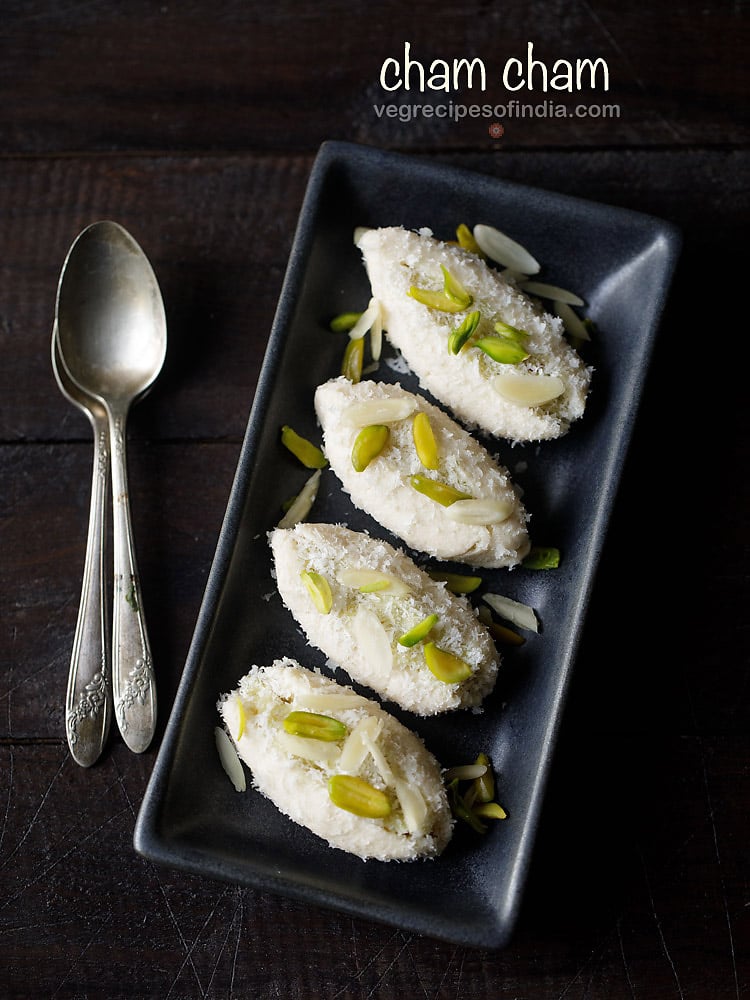
What is cham cham
As mentioned in the beginning, Cham Cham, popular locally as Chom Chom is another mishti (sweet) that Bengalis take pride in. And to be honest, it really is a fab one. Basically, a milk-based preparation, the main ingredients of Cham Cham Sweet include curdled milk (chhena), all-purpose flour and sugar.
Milk is curdled to get chenna or coagulated milk solids. This chenna is further kneaded and then shaped in cylindrical or oblong pieces, which are then cooked in sugar syrup.
There are many Chom Chom variations that may be stuffed, like my recipe here or even plain flavored with essences, spice powders, etc. It is also not mandatory for this particular sweet to be simply white in color.
So, you may find others in shades of light yellow, light pink, light orange, etc. This mithai (sweet) may or may not be covered with coconut or even khoya, which usually forms the garnish. It is definitely the closest cousin of the other Bengali favorite, the rasgulla.
When you make sweets like cham cham or Rasgulla, what one looks for is sponginess, softness and smoothness in the texture. I am sharing some frequently asked questions along with tips so that you can make absolutely awesome cham cham sweet in your own kitchen.
I have compiled the questions from comments received from the other chenna based sweets (as the method of making these is similar) shared on blog.
Faq for cham cham recipe
1. What should be the quality of milk?
While making chenna based sweet like cham cham, rasgulla or sandesh, always use full fat whole milk. You can even use pasteurised milk. Also make sure that the milk is fresh and is in its shelf period. Avoid using toned milk or skimmed milk.
2. How to gauge the correct moisture in the chenna?
The correct balance of moisture is very crucial to get the right texture in cham cham or a rasgulla. If there is too much of water or moisture in the chenna, the cham cham will break or disintegrate while cooking. Too less moisture, then the cham cham will become dense or shrunk or flatten after cooking and cooling.
- You can easily check the moisture content in chenna while kneading it. when you knead chenna, if you see that it is too moist or watery, then it means there is more water. Add a bit of more maida (all purpose flour) so that it absorbs the extra moisture. You can keep a heavy weight on the chenna so that some of the water or whey reduces.
- If when kneading, if you see the chenna dry and crumbly, then there is less moisture. Sprinkle 1 to 2 teaspoons of water to make the chenna slightly moist. The moisture helps in binding and makes soft cham cham, but at the same time, there should not be too much of moisture or water in the chenna.
3. For how long chenna needs to be kneaded?
The time taken for kneading chenna depends on the force and pressure applied by the palms. However as a benchmark, stop kneading when your palms become a bit greasy.
While kneading, some fat from the chenna is released. So your palms must become a bit greasy when kneading. At this step stop kneading and shape chenna into chum chum. Knead chenna to a smooth large ball and it should be able to come together without breaking or falling apart.
4. Does the sugar syrup has any string consistency?
The sugar syrup for cham cham does not have any string consistency like 1 string or 2 strings etc. Its a watery sugar syrup. Since it watery, the cham cham absorbs the sugar syrup and tastes sweet.
5. Why has cham cham flattened or shrunk?
When cooking cham cham, always use a large pan enough for all the cham cham pieces to accomodate and expand when cooking. Do not stir with a spoon or ladle as the chum chum can break. Its better to use a pan with handles at the sides, so that you can shake the pan by holding the handles and swirling the pan gently. If the chenna is dry, then also the cham cham can get shrunk or flattened.
6. How to check if the cham cham is cooked?
Firstly the cham cham expand in size while cooking. Overall the cooking time varies from 8 to 12 minutes. The time variations are due to the size of the cham cham, the quality and type of pan, flame intensity etc.
So after 8 to 10 minutes, you can remove a cham cham piece and place it in a mug or bowl of water. If the chom chom settles at the bottom, its cooked. If it floats on the surface of water, its undercooked.
7. Why has cham cham become rubbery?
If the cham cham pieces are cooked too much, they will end up becoming dense and rubbery. So do not overcook them.
8. Can I make colored cham cham?
Of course you can. Colored cham cham also appeal to kids. If using any coloring ingredient, I would suggest to use natural color extract. So add the natural color extract in the chenna while kneading, to get colored cham cham sweet. You can divide the chenna in two or three portions to get 2 to 3 colored varieties of chum chum.
9. Is the sweet filling essential?
No, making the sweet filling is not essential. You can skip it completely. Also rolling chum chum in desiccated coconut is optional and can be skipped.

How to make Cham Cham Sweet Recipe
Making chenna for cham cham recipe
1. Take 1 litre of milk in a pan and keep it to boil on a low to medium flame. Stir at intervals when the milk begins to get heated.

2. When the milk comes to a boil, you will see a layer of malai or clotted cream which forms on top. Remove this layer of malai. You will get about 2 to 3 tablespoons of malai. Keep this malai aside. We will be using this malai to make the sweet filling for cham cham.

3. Let the milk come to a rolling boil. Switch off flame when milk comes to a rolling boil.
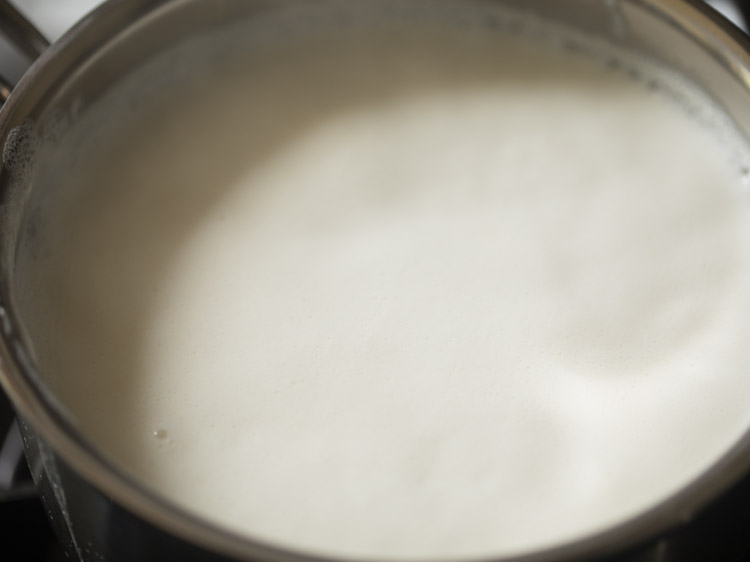
4. Add 2 tablespoons vinegar or lemon juice. You can even add 1 or 3 tablespoons vinegar or lemon juice. The amount to be added will depend on the quality of milk.

5. Mix very well and let milk curdle.

6. Wait for 4 to 5 mins and let the heat reduce a bit. then strain through muslin lined on a top of a bowl or pan.
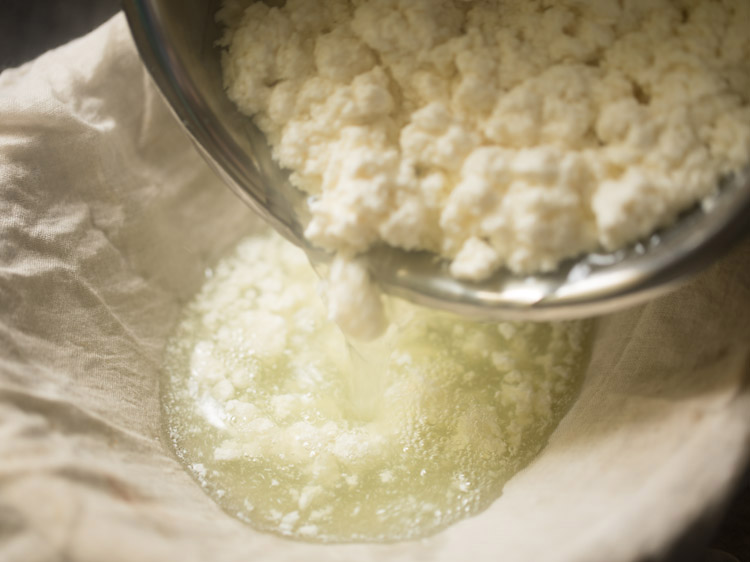
7. Bring the edges of the muslin together, straining all the whey. Be careful as both the chenna and whey will be hot.
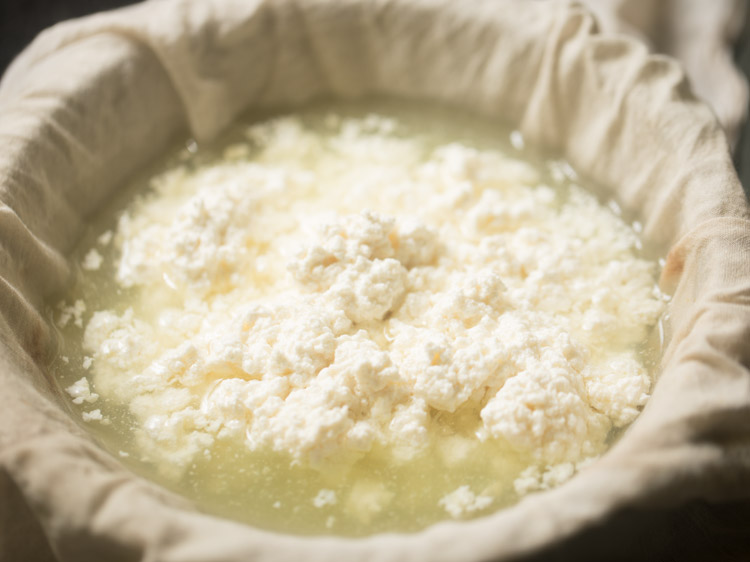
8. Rinse the chenna very well in running water. This removes the lemony flavor and tangy taste from the chenna. Then gently queeze the muslin with your hands, so that any extra water is drained from the chenna.
Remember there should not be excess water or moisture in the chenna as then the cham cham will break when cooking.
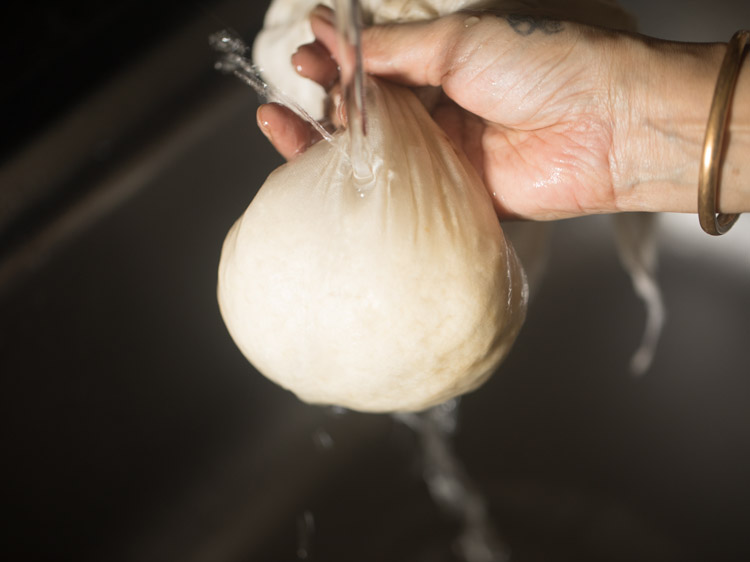
9. Keep a heavy weighted bowl or mortar-pestle on the chenna for 8 to 10 minutes.

10. After 8 to 10 minutes remove the chenna from the muslin. Place on a tray or a plate. Sprinkle 1 teaspoon maida or all purpose flour. You can even add 1 teaspoon rava or corn flour instead of maida.

11. Mix and begin to knead this mixture. Mash chenna with the heels of your palms and knead. Also keep on collecting the chenna from the sides and continue to mash and knead. Knead very well till a bit of greasiness is felt in your palms. Just a bit of greasiness is required. Do not knead till the whole chenna becomes greasy.
If the mixture looks dry and crumby then sprinkle some water – about 1 to 3 teaspoons or more and continue to knead. the chenna mixture should be able to come together without breaking or falling apart. For a dry chenna, a bit of moisture helps in binding the mixture.

12. Knead chenna to a smooth large ball.

13. Then shape into a log and cut in equal pieces. You can even make small balls from the kneaded chenna.

14. Take each piece and roll them between your palms to a smooth cylindrical or oblong shape.
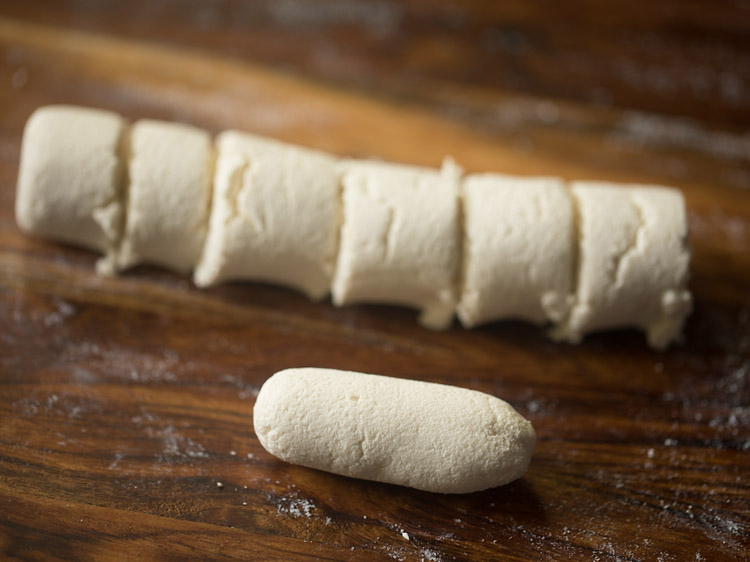
15. Pinch the edges.

16. Make oblong shaped cham cham with all the pieces.

17. Keep them covered with a moist muslin cloth.

Making sugar syrup for chum chum
18. Take 2 heaped cups sugar (400 grams) in a large pan. Please use a large pot or pan with handles, so that there is enough space for the cham cham to cook and increase in size.
I used a 3.4 litre stainless steel pan measuring 8.5 inches in diameter and 4.5 inches in height.
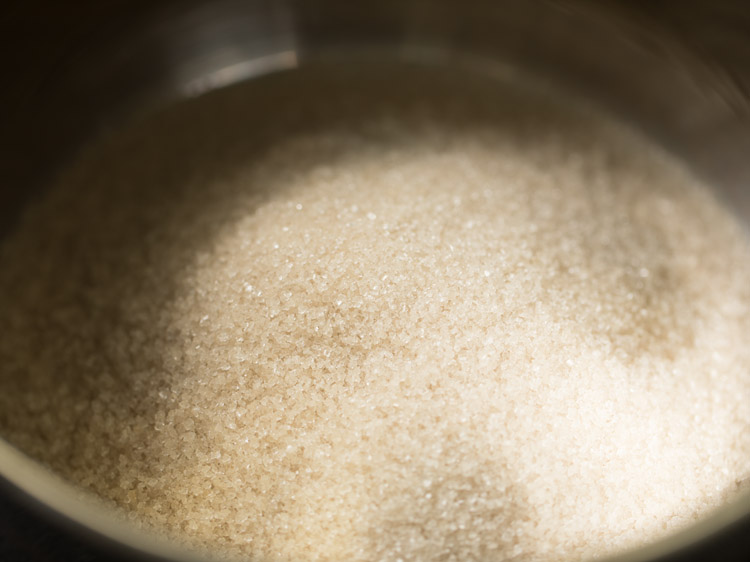
19. Pour 4 cups water (1 litre) in the pan.
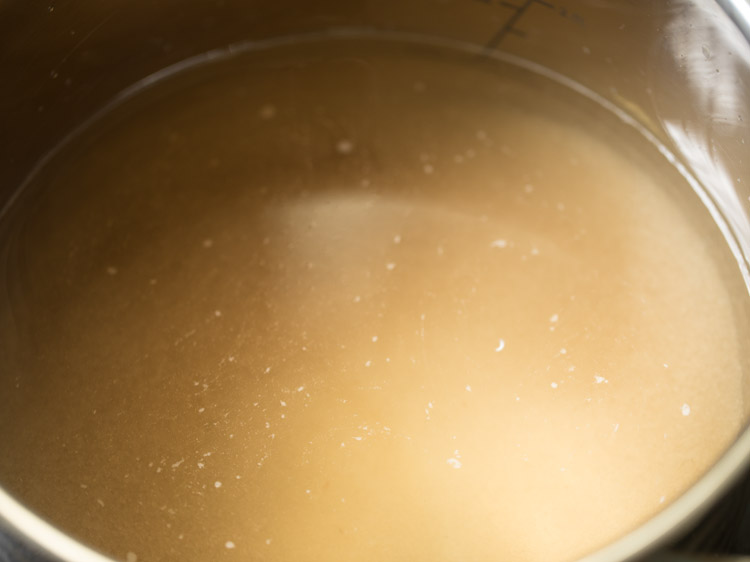
20. Place the pan on a medium-low to medium flame. With a spoon stir non-stop and mix so that all the sugar is dissolved.
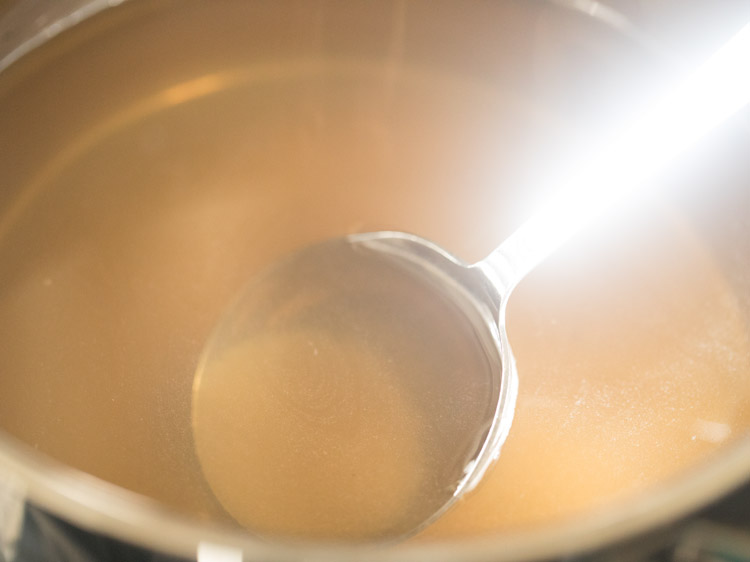
21. When all the sugar is dissolved, remove 1 cup of sugar solution and keep it aside.
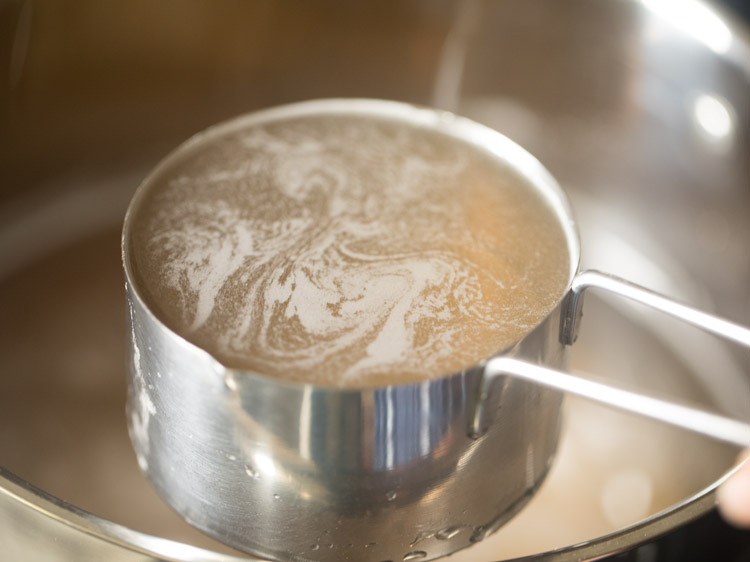
22. Then let the sugar solution come to a boil on a medium-high flame.

23. When the sugar solution comes to a boil, then carefully place the cham cham in the sugar solution. Gently shake the pan holding the handles at the sides.

24. Cover the pan with lid and boil cham cham on medium-high flame for 5 minutes.
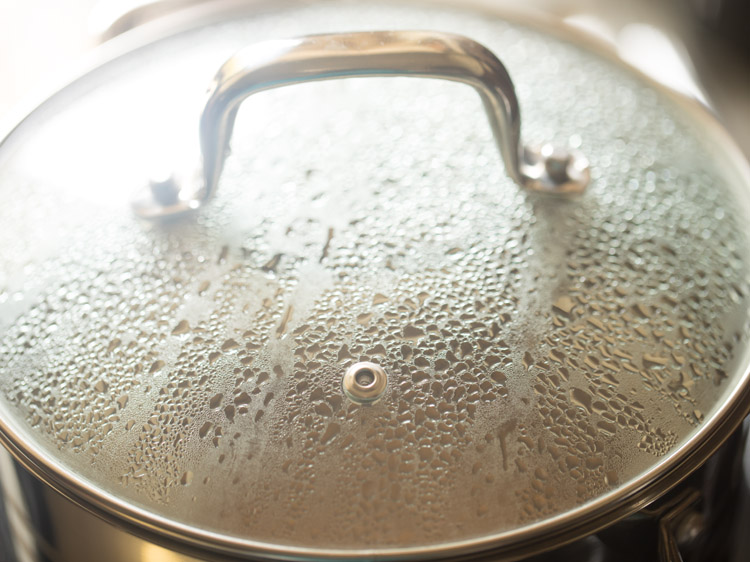
25. After 5 minutes in a gentle stream slowly add the 1 cup of reserved sugar solution.
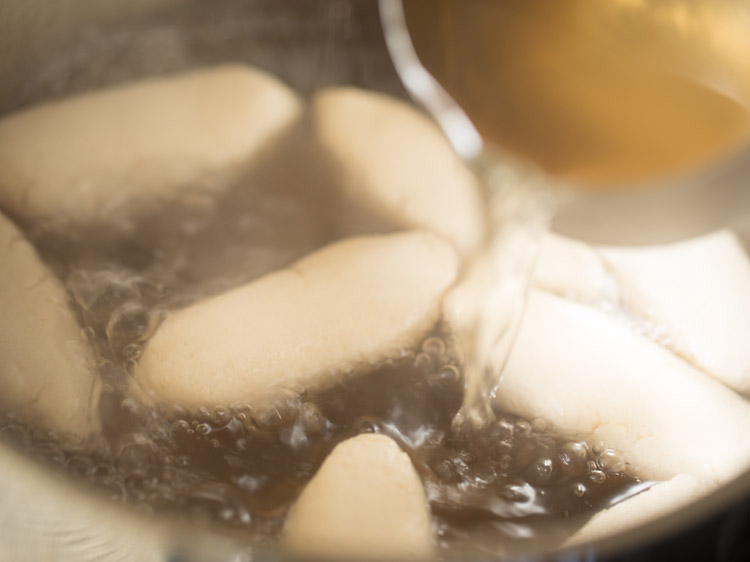
26. Hold the pan at the handles and gently shake it.

27. Cover again with lid and cook covered for 7 minutes. I cooked for a total of 12 minutes. The cooking time will vary with the intensity of flame, pan type and size etc. So the total time taken for cooking can vary from 8 to 12 minutes. Do not overcook the chom chom pieces, as they become rubbery and dense.
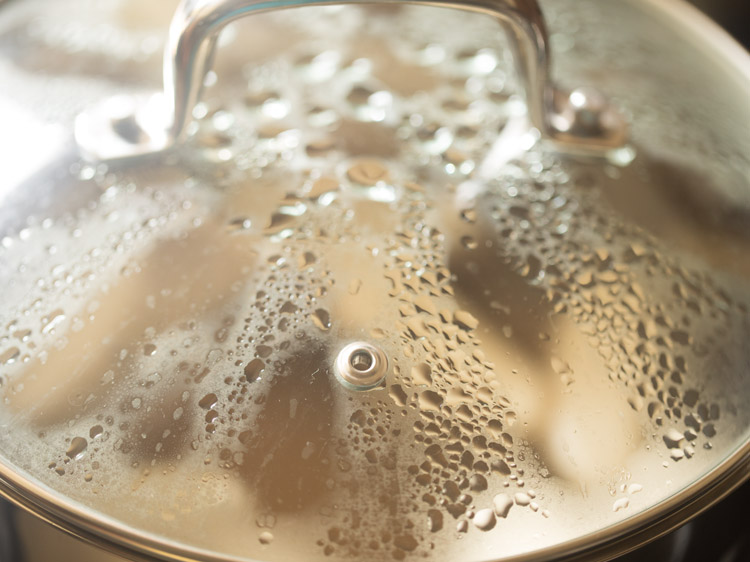
28. After 8 to 10 minutes, you can check using this method to see if the cham cham are cooked. To check take one chum chum and place it in a bowl or mug of water. It should settle down at the bottom. If it floats then the cham cham needs to be cooked for a few more minutes.
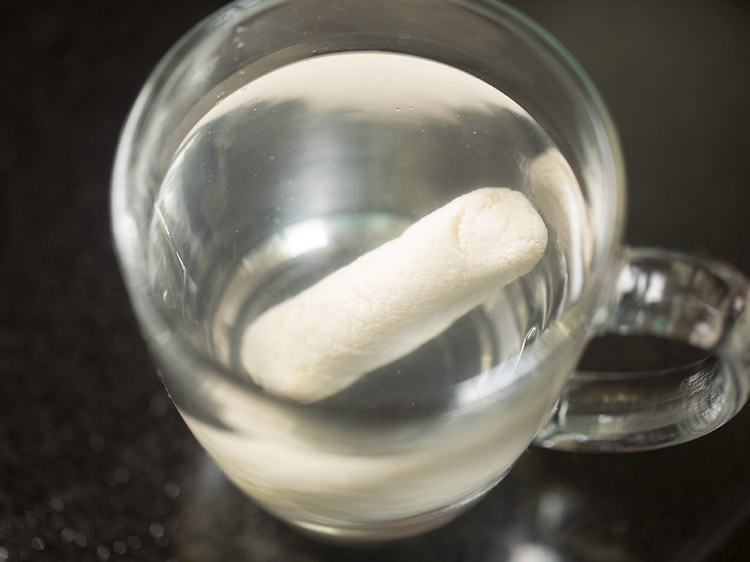
29. Once the chum chum are cooked, switch off the flame. Keep the pan down and remove the lid.

30. After five minutes add 1 tablespoon kewra water or rose water. You can also add ½ to 1 teaspoon cardamom powder. mix gently. Let cham cham cool completely.
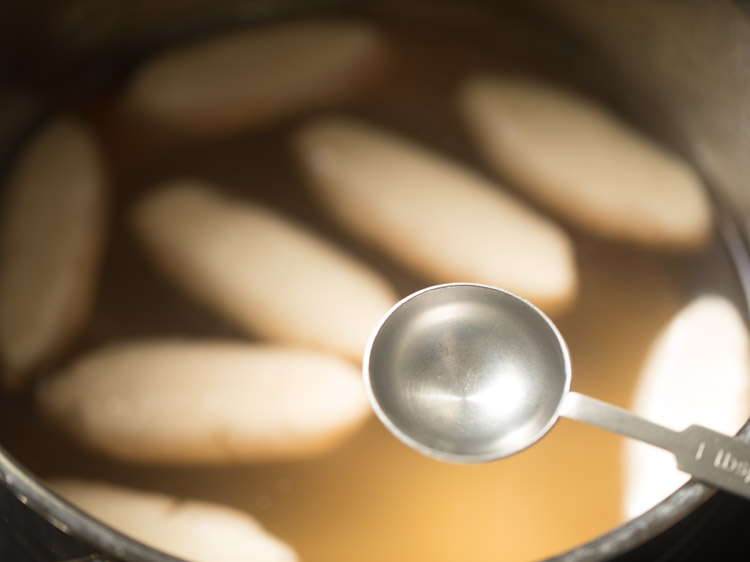
Making stuffing for cham cham
30. In a heavy kadai or pan, take 6 tablespoons milk powder, 2 tablespoons sugar, 7 to 8 strands saffron and ¼ teaspoon cardamom powder.
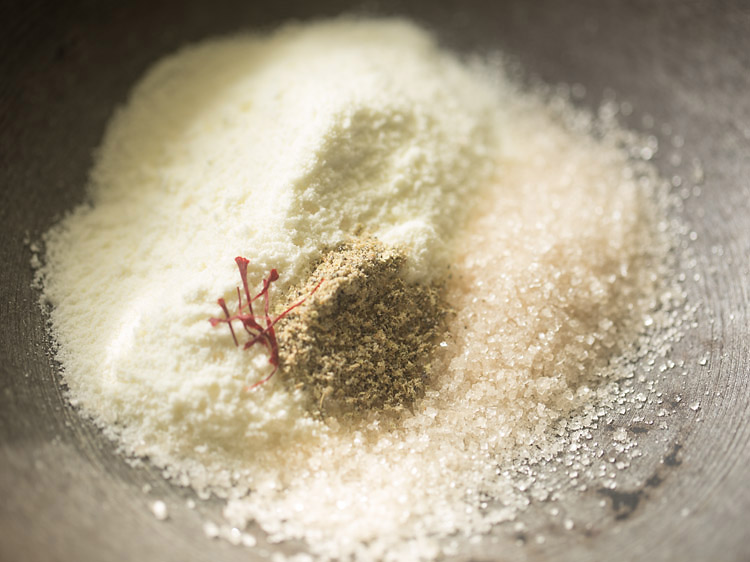
31. Next add 2 tablespoons malai or cream reserved from the milk when we had boiled it. Also add 2 to 3 tablespoons milk.
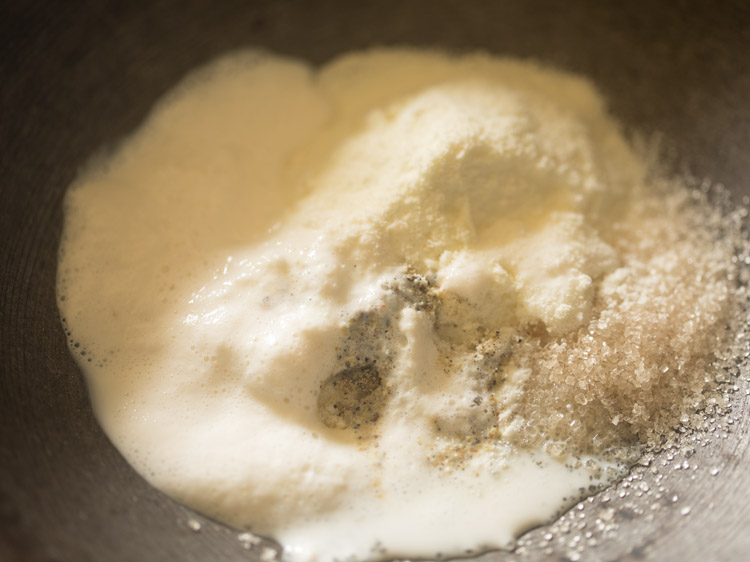
32. Mix everything and keep pan or kadai on a low flame.

33. Stirring often begin to cook this mixture.

34. The mixture will begin to thicken. stir continuously and cook till the mixture leaves sides of pan. let this mixture cool completely. Again here do not over cook this mixture as then it becomes chewy and sticky. In case it becomes chewy and sticky, then sprinkle some milk or water (1 to 2 tablespoons) on it and gently heat through.

Making stuffed chum chum
35. Place cham cham on a tray and board. with a knife make cut each cham cham on top. Do not cut the cham cham entirely.

36. Pull part the cut sides and place the stuffing in the cham cham carefully without breaking them.
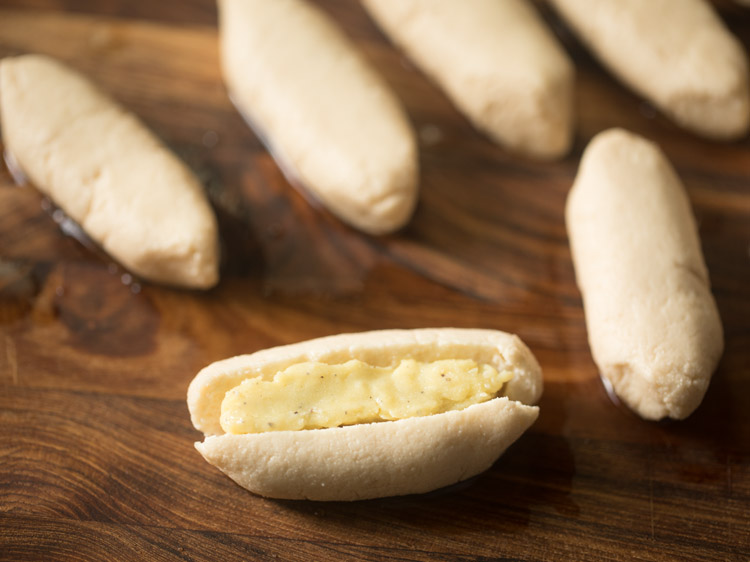
37. Stuff all the cham cham pieces this way.
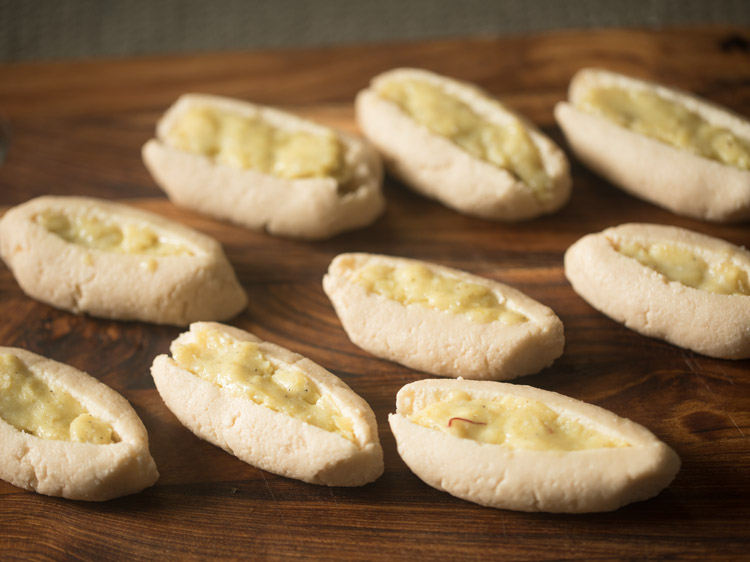
38. Take 2 to 3 tablespoons desiccated coconut in a plate and gently roll cham cham so that the desiccated coconut sticks to the cham cham.

39. Do this with all the cham cham pieces.

40. Place each cham cham on a serving plate or tray. Garnish with sliced pistachios and almonds.

41. Serve cham cham. or you can chill cham cham and then serve later. Refrigerate any leftover cham cham pieces.

A few more sweets recipes you may like are:
Please be sure to rate the recipe in the recipe card or leave a comment below if you have made it. For more vegetarian inspirations, Sign Up for my emails or follow me on Instagram, Youtube, Facebook, Pinterest or Twitter.

Cham Cham Sweet Recipe | Bengali Chum Chum Recipe
Ingredients
for chenna
- 1 litre milk
- 2 tablespoons vinegar or lemon juice or add as required
- 1 teaspoon maida or all purpose flour or rava (sooji, cream of wheat) or corn flour
for sugar syrup
- 2 heaped cups sugar or 400 grams
- 4 cups water or 1 litre
- 1 tablespoon rose water or kewra water or ½ to 1 teaspoon cardamom powder
for sweet filling
- 6 tablespoons milk powder
- 2 tablespoons sugar
- 2 tablespoons malai or cream
- 2 to 3 tablespoons milk
- 7 to 8 strands saffron
- ¼ teaspoon cardamom powder
for garnish
- 2 to 3 tablespoons desiccated coconut
- 1 to 2 tablespoons chopped or sliced blanched almonds or raw almonds
- 1 to 2 tablespoons chopped or sliced pistachios
- few strands of saffron – optional
Instructions
making chenna
- Begin to heat 1 litre milk in a thick bottomed pan. Stir at intervals when the milk begins to get heated.
- When the milk comes to a boil, you will see a layer of malai or clotted cream which forms on top. Remove this layer of malai. You will get about 2 to 3 tablespoons of malai. We will be using this malai to make the sweet filling for cham cham.
- Switch off flame when milk comes to rolling boil.
- Add 2 tablespoons vinegar or lemon juice. You can even add 1 tablespoon vinegar or lemon juice. The amount to be added will depend on the quality of milk.
- Mix very well and let milk curdle.
- Wait for 4 to 5 mins and let the heat reduce a bit. Then strain through muslin lined on a top of a bowl or pan.
- Bring the edges of the muslin together, straining all the whey. Be careful as both the chenna and whey will be hot.
- Rinse the chenna very well in running water. This removes the lemony flavor and tangy taste from the chenna. Then gently queeze the muslin with your hands, so that any extra water is drained from the chenna.
- Keep a heavy weighted bowl or mortar-pestle on the chenna for 8 to 10 minutes.
kneading chenna
- After 8 to 10 minutes remove the chenna from the muslin. Place on a tray or a plate. Sprinkle 1 teaspoon maida or all purpose flour. You can even add 1 teaspoon rava (sooji) or corn flour instead of maida.
- Mix and begin to knead this mixture. Knead very well till some greasiness is felt in your palms. Just a bit of greasiness is required. Knead to a smooth ball of chenna. If mixture looks dry and crumby sprinkle some water – about 1 to 3 teaspoons or more and continue to knead. The mixture should be able to come together without breaking or falling apart. For a dry chenna a bit of moisture helps in binding the mixture.
- Then roll the chenna ball into a log. cut in equal pieces.
- Take each piece and roll them between your palms to a smooth cylindrical or oblong shape. pinch the edges.
- Make oblong shaped cham cham with the entire kneaded chenna. keep them covered with a moist muslin cloth.
making sugar syrup for chum chum
- Take 2 heaped cups sugar (400 grams) in a large pan. Please use a large pot or pan so that there is enough space for the cham cham to cook and increase in size.
- Pour 4 cups water (1 litre) in the pan.
- Place the pan on a medium-low to medium flame. With a spoon stir non-stop and mix so that all the sugar is dissolved.
- When all the sugar is dissolved, remove 1 cup of sugar solution and keep it aside. let the sugar solution come to a boil on a medium-high flame.
cooking chom chom
- When the sugar solution starts boiling, carefully place the chum chum in the sugar solution. Gently shake the pan holding the handles at the sides.
- Cover the pan with lid and boil chum chum on medium-high flame for 5 minutes.
- After 5 minutes in a gentle stream, slowly add the 1 cup of reserved sugar solution. hold the pan at the handles and gently shake it.
- Cover again with lid and cook covered for 7 minutes. I cooked for a total of 12 minutes. The cooking time will vary with the intensity of flame, pan type and size etc.
- To check if the cham cham has cooked, take one piece and place it in a bowl or mug of water. It should settle down at the bottom. If it floats then the cham cham needs to be cooked for a few more minutes.
- Once the chum chum are cooked, switch off flame. Keep the pan down and remove the lid.
- After five minutes add 1 tablespoon kewra water or rose water. You can also add ½ to 1 teaspoon cardamom powder. Shake the pan gently. Let cham cham cool completely.
making stuffing for chum chum
- In a heavy kadai or pan, take 6 tablespoons milk powder, 2 tablespoons sugar, 7 to 8 strands saffron and ¼ teaspoon cardamom powder.
- Next add 2 tablespoons malai or cream reserved from the milk when we had boiled it. Also add 2 to 3 tablespoons milk.
- Mix everything and keep pan or kadai on a low flame.
- Stirring often begin to cook this mixture.
- The mixture will begin to thicken. Stir continuously and cook till the mixture leaves sides of pan. Let this mixture cool completely.
making chum chum
- Place them on a tray and board. With a knife make cut each cham cham on top. Do not cut the cham cham entirely.
- Place the stuffing in the cham cham sweet carefully without breaking them.
- Stuff all the pieces this way.
- Take desiccated coconut in a plate and gently roll cham cham sweet so that the desiccated coconut sticks to the cham cham.
- Do this with all the cham cham pieces.
- Place them on a serving plate or tray. Garnish with sliced pistachios and almonds.
- Serve cham cham. Or you can chill them and then serve later. Refrigerate any leftover pieces.
Notes
Nutrition Info (Approximate Values)
This Cham Cham Sweet post from the archives first published in October 2018 has been updated and republished on February 2023.








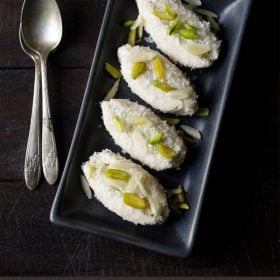
Hello dassana,
My daughter is a big foodie who like to eat vegetarian food along with non veg food. Coming from a Muslim background I know how to cook non veg and also have the whole family to help,but vegetarian cooking is new ground for me. My daughter shares tiffin with her friends and then comes home with request plz cook red Dal( rajma???? ). You have been my savior for many recipes now.chole nature being her favorite. I have also tried you golgappa. My daughter’s mouth starts watering as Soon as I take the name.Thank you so much.may God bless you for sharing your knowledge. And bless us with more recipes from you.
hi parsa, so glad to read your comment and i am also glad that your daughter loved the vegetarian recipes you made from the blog. thanks for your kind wishes too. sure, i will be adding more recipes.
most welcome and i wish you and your family good wishes and good health.
regards
dassana
Hi Mam. Cham Cham is my favourite sweet after Rosogolla. Tried your recipe today and the Cham Cham were so good. Soft, spongy and very tasty. I did not have coconut powder. So could not add it, but still the taste was awesome. Thanks.
thank you sharmila for this lovely feedback on cham cham recipe. coconut powder can be skipped if you do not have it. welcome and happy cooking.
Drooling post Dassana Ma’am.
thank you richa.